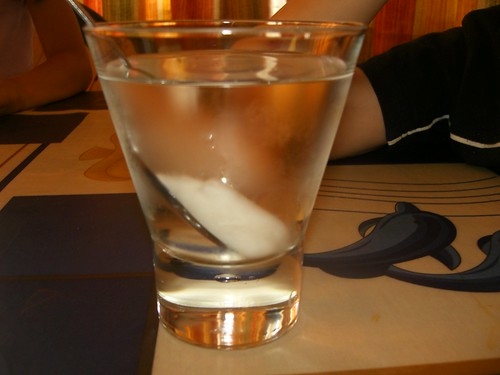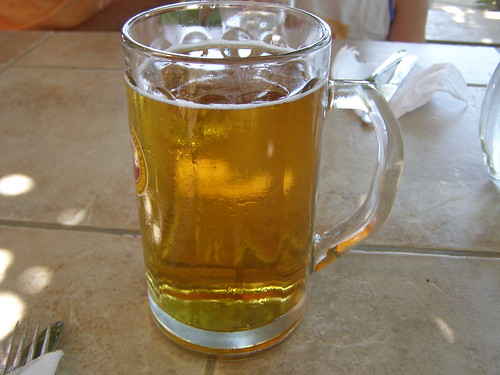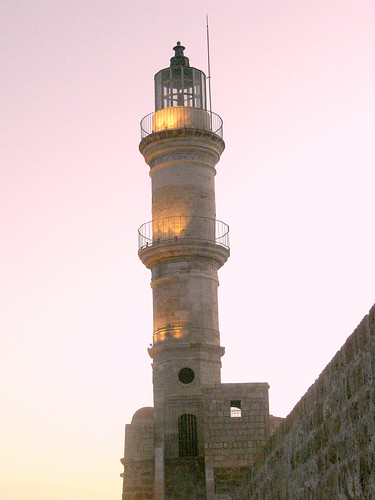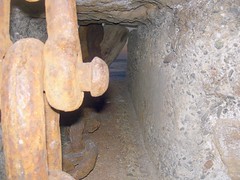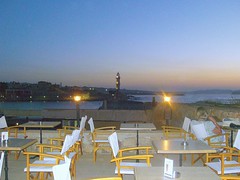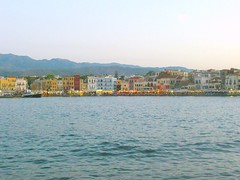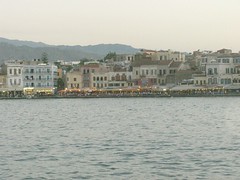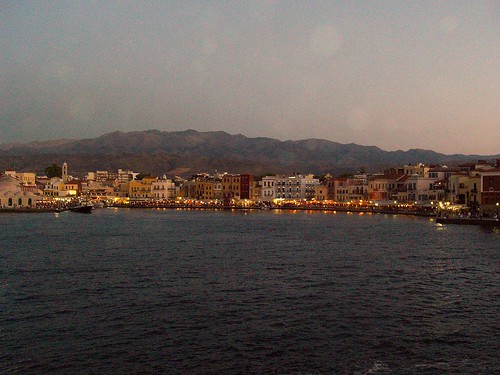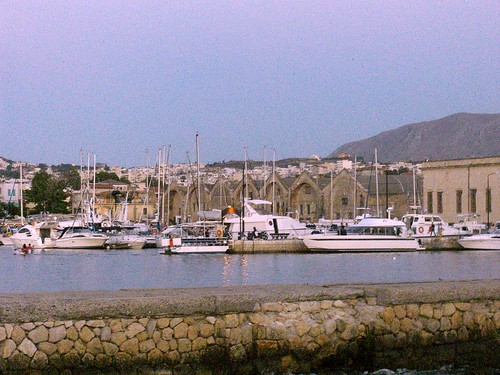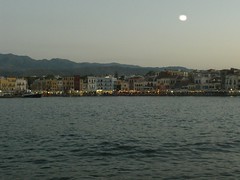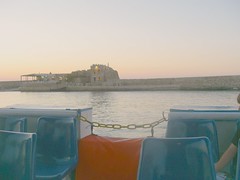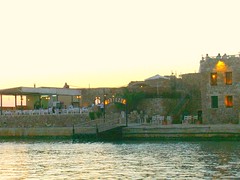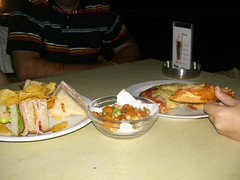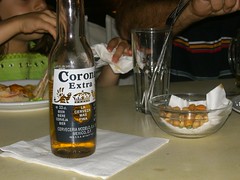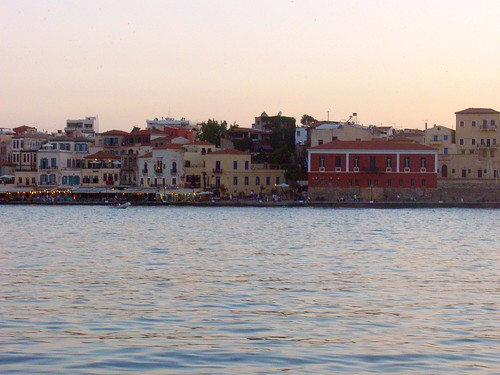The 2nd Symposium of Greek Gastronomy took place in the mountain hamlet of Amari, in the prefecture of Rethimno. I had heard so much about the Amari Valley, that it was one of the most beautiful and most unique areas in the whole of Crete; I live in what I would characterise as a beautiful area myself, so I felt that the opportunity given to me to go to Amari was a purposeful one - Amari is a place that would never have crossed my mind to visit unless there was a good reason to go there.
It looked quite easy on the map to get to Amari, although there seemed to be a number of roads that left to Amari. I chose what seemed like the shortest route. I never carry paper maps with me these days when I am driving through the island, since Google's maps are readily accessible on a mobile phone. Phone signals are usually quite strong, and most roads are well signposted.
The Google directions stated that the approximate time needed for this 92km drive was 1h and 38 minutes - it takes me just 5-10 minutes more to drive 138km to Iraklio (albeit on a straight road). Having never been to Amari before, I couldn't argue. I began my journey just before 7am on Sunday morning on the National Road, which is a clean wide motorway basically running the length of the island.
At the point where I was supposed to turn off the motorway (just past the town of Rethimno), I found myself in what looked like a bumper-to-bumper traffic jam during the rush hour. Alas, there were roadworks, resulting in all sorts of diversions, which means that everything had been turned topsy turvy: the road lost its clean tidy look, it became precariously narrow, it stopped looking familiar, and worst of all, the signage was either seriously lacking, or it had been replaced by temporary signs which pointed to what looked like snail-like pathways leading off into dark unexplored territory.
As I was trying to keep my wits about me, and looking out for these temp signs, I suddenly saw the classic Greek blue road sign with the yellow writing, that I had been looking out for:
AMARI--> But I was too late: I had practically driven right past the sign. So I just turned off at the next road which was unmarked and hoped that I would eventually find the right road. SO close and so far away...
The unknown path led me to what sounded like Platanias, a suburb near the town of Rethimno, where a taxi driver was dusting down his cab. Taxi drivers know
everything most things, so I stopped in the middle of the road and got some directions, which sounded like
turn left, Prasies, keep going, pass the gas stations, Prasies, go over the bridge, turn here, Prasies, then there Prasies, and don't worry, Prasies, it's all signposted, the last of which I did not believe. Yes, there were signs all over the place, but none mentioned Amari. For such a prominently displayed sign at the motorway exit, how on earth did Amari disappear from the map?
 |
| Very old stone wall - xerolithia - on the road to Amari |
Prasies turned out to bear some significance after all, since there was indeed a sign directing people to Prasies, so I just turned into it. At any rate, there was no sign directing anyone to Amari, only to Prasies. It seemed like you would only be allowed to go to Amari if you went first to Prasies, as if you had to pay some kind of dues.
I remembered the name of the village Prasies from another drive through the prefecture of Rethimno. I had actually been close to Amari in the not too distant past. When
the Fragma (an artificial lake) opened, we visited the area during the spring. It was one of the widest most empty spaces that I had ever visited in Crete. Very beautiful... yes, but very unique? No, not really, I had seen many places like this in other parts of Greece (as well as Hania, which is about to get its own artificial lake soon, in the Vatolakkos area). There was only one taverna in the area, where we sat after our visit.
Approaching the lake district, I noticed that the sole taverna where we had eaten was now also a 'zoo', a 'bird park' and a 'children's multi-space area'. Wherever there is a sight worth seeing in Greece, a taverna or cafe or bar or shop - any kind of money spinner - sprouts up out of nowhere, and some of those business seeds had been sown in the area. The taverna did not remind me of the traditional low-key eaterie we had visited over two years ago, and of course, it looked overly garish, as most hyped-up businesses in the middle of nowhere usually do; this is the only way that the locals know about how to get noticed.
 |
| One of the sprouting cafes I passed on my most recent trip through the Amari valley. |
But who on earth would notice this place anyway, I wondered, as there were hardly any cars on the road from the moment I left the Rethimno area. Western Crete is known for its relatively high levels of sun-sea-sand tourism, but agro-tourism - while highly popular - is still struggling to work out its customer base. For people to come off the beaten track and get onto one which isn't very well signposted would be asking too much for the average tourist - they would need to be enticed here in more conventional ways. Passing trade here could only be described as a miracle waiting to happen: most of those businesses were built for exactly that, a snatch and grab chance to make a quick buck, and then, it's over.

While I was thinking that I was in the middle of nowhere with nothing to do or see except gorges, mountains and fields, the road narrowed suddenly, as a sign indicated just before I arrived here. I caught sight of a bridge of some sort. But what a bridge! It was built by the Venetians, and looked just like it belonged somewhere in the Italian countryside. Could I be in Tuscany right now, and not Crete? There was hardly any place to park on the edge of the road (you would still be in the middle of it), so I just carried on driving and didn't look back, just in case my curiosity turned me into a pillar of salt. I could feel myself running late already.
 |
| Part of the meal we had at the Fragma taverna in spring 2011. |
The sight of that taverna (despite having morphed into a kids' zone) gave me a false sense of security, as I felt that I was on familiar territory, and I could feel Amari within my reach. But no sooner had I passed the taverna, that I came across a fork in the road that confused the living daylight out of me. And again, no signs. I felt lost, in the middle of nowhere, with no signs of any human being in sight, only a huge flock of sheep, some of the dumbest creatures I have come across in a long time. On hearing the car approaching, they looked up and stared at me before looking in front of them to see where all the other sheep were going. Then they followed them silently, each slow one by the other slow one, until, after what seemed like a lifetime, they had all moved off the road and let me pass.
 |
| A hotel in the middle of nowhere, swimming pool included! |
I was going to stop anyway, to decide which road I would take, when along came a pick-up truck from the left tine of the fork which looked rather narrow, was down hill and led to what seemed like something dark and hidden. I was on the right tine. The driver of the truck gave me a long hard stare, which I later realised was common among the older locals in the area. They see more animals on most days than they do humans, so my appearance at that moment was somewhat of an oddity. He could tell I wasn't from his parts. Before I was about to ask him which road to take, he bet me to it and asked me where I wanted to go. "Down here," he indicated to the road he had just sprouted from, "for the Fragma." In my misfortune of not really knowing where I was going, I was lucky to find this critter; for sure, I would have taken the other road which was wider and brighter, with a view of the open sky.
 |
| To arrive up here, you come from a road on much lower ground, a sign that you are entering a valley area. |
As I made my way along the dark and windy roads, I wondered where the lake, which was built in a former valley, would appear. After what seemed like perpetual darkness on unnamed territory, I found myself driving onto an unkempt narrow road, which abruptly became just wide enough for one car to pass. Interestingly, that was signposted. What I was just about to pass over was a steep stretch of road, at the top of which appeared a dazzlingly blue shiny lake. It was the one place I felt like stopping at throughout the journey so far. Who wouldn't be tempted to stop here, lured by the sapphire colour of the waters. I continued driving, in search of my final destination, because I could not afford to lose time on the road. The Symposium started at 9am, and I was speaking at 10.30 - it was already 8.15 when I arrived at the lake.
 |
| The lake is directly in front of this sign - Amari is only 11 kilometres away from this point. |
The driving was not so difficult now since there was only one road to take, with the lake beside me. I remembered the map: Amari can't be far away now, I thought to myself. Just keep on the road and drive directly, without turning off the the road... it must be somewhere here, despite the lack of signage. And all of a sudden, once again, I had a deja vu moment as I came across a junction which I remembered as the place where we had stopped the car to enjoy the lake views. I remembered this crossroad from the sign - but Amari was not listed and there was absolutely nothing in the area that would be able to tell me which road to take.
Just as I was wondering if I should continue along the lakeside, or take the road leading away from the lake, into the mountains, another car pulled up out of nowhere, laden with people. A papou was driving, with a yiayia next to him who was holding a toddler on her lap. The were two more children in the back seat, along with two young adults.
 |
| I think this is Amari village, viewed from the opposite hillside |
"Where would you like to go to, young lady?" the papou asked me. "Pantanassa?" Pantanassa is a monastery, in a most fitting location. They were dressed in their Sunday best, so they were obviously going for the Sunday service.
"I want to go to Amari," I told them. The papou explained that I could take either road to get there, as if all roads here lead to Rome. The lakeside road was in a bad condition but it was the shorter of the two routes (9km away), while the higher road was longer (11km) but in a better condition.
"If you want, you can follow us," he said. "We're going to Panatanassa, and you can continue on to Apostoloi." No mention was made of Amari! But I felt safer this way, so naturally I followed him. The road would up and down again, as I drove through what felt like a gorge running through the mountains. Just before the church, I passed what looked like the entrance (or was it the exit?) to the famous St Antonios gorge, a place lush in greenery, with a cave in its midst which has been turned into a church. More temptations for me, that I would have to leave for a next time, although I could not imagine when that next time would come for me.
 |
| Amari village, view from the school |
Just before the family turned off for Pantanassa, they showed me the road for Amari. "Would you like to come to the church before you go to Amari?" the yiayia asked me. "It's very beautiful. You can light a candle and kiss the icon before you continue to Amari." Not being particularly religious, I found it easy to say not to that one.
I couldn't be far away now, only perhaps another 4, 5, 6 or so kilometres... And still no sign of a sign for Amari, only for Apostoloi. And no wonder: when I reached Apostoloi, I found a village buzzing with life. The cafes were full of people enjoying the cool mountain air on this hot day in July - in fact, the whole area felt cool. Tucked away in the middle of the mountains and gorges and fields and narrow roads, in the midst of olive groves and grapevines, I found myself wanting to stop at the cafe and find out how long these people had been living here. There were people of all ages, including young children, both men and women.
So have you felt the effects of the economic crisis? How often do you leave the village? What do you cook on a daily basis? Do you know how to get to Rethimno? This isolated community could not possibly have seen any homelessness, poverty or hunger near them, nor do they look as though they are about to migrate at any point in the near future. They've been here for pretty much ever, and that is the way it will probably stay.
 |
| Amari vilage, the kafeneio |
Only five or so kilometres to go, and I encounter another fork on the road! To take the right fork this time, I turned back to the village I had just passed and asked someone, as it was unlikely that anyone would appear from here on to lead me to Amari. They directed me to take the lower road for the village Sxoli Asomaton, which would lead me to Amari. And still no sign whatsoever. I suppose no one needed a sign at this point to got to Amari. Who would come here anyway, except someone who already knows the place? On my part, I was beginning to get tired of all this chasing up Amari. What will I find there once I get there?
 |
| Amari village, the school |
And finally, a sign:
AMARI--> 2 So I was only two kilometres away... I entered the village just before 9am, where I found myself directly in front of the village square. There was enough space for me to conveniently park my car. On the left was the former village school, a well-maintained building which also had a kitchen attached to it, a symbol of the importance of the village in former times. All roads led eventually to Amari. I later found out that most of my colleagues ended up arriving 2 1/2 hours after they started from Hania because they got much more lost than myself - for me to make it in less than 2 hours meant that I had done very well!
 |
| I had an old-fashioned biral (a fizzy drink popular in Crete, tasting kind of like Coca-Cola), made form Mt Ida water. Mt Ida is better know to us as Psiloritis, where it is said that Zeus, the king of the gods was born. |
On that day, I did not get further than that village square. I had found Amari, and for me, that was enough for the time being. While I sorted out the business I had to attend to in Amari, my mind was on the return journey; I thought I had an idea of the temptations it had to offer, but I was wrong. On leaving the village, I relaised I had taken a different exit. A tiny tanned man was standing on the roadside, showing his crooked teeth, and wearing clothes that looked as though they were very old but had never been dirtied enough to need washing.
"Am I going OK for Rethmino?" I asked him.
"Sure," he said "you'll reach the village of Spili in a quarter of an hour from here."
Spili? I had visited that years ago, but I had not passed it this time round! My Odysseyan journey would not finish until I had arrived home. The next time I go to Amari, I will make sure to take a different route.
©All Rights Reserved/Organically cooked. No part of this blog may be reproduced and/or copied by any means without prior consent from Maria Verivaki.
























